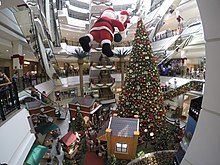
Back Ekonomický význam Vánoc Czech Julehandel Danish Economía de la Navidad Spanish Julhandel Swedish
The examples and perspective in this article deal primarily with the English-speaking world and do not represent a worldwide view of the subject. (June 2015) |


The economics of Christmas are significant because Christmas is typically a high-volume selling season for goods suppliers around the world. Sales increase dramatically as people purchase gifts, decorations, and supplies to celebrate. In the U.S., the "Christmas shopping season" starts as early as October.[1][2] In Canada, merchants begin advertising campaigns just before Halloween (31 October), and step up their marketing following Remembrance Day on 11 November. In the UK and Ireland, the Christmas shopping season starts from mid-November, around the time when high street Christmas lights are turned on.[3][4] In the United States, it has been calculated that about one fifth of retail sales[5] to one quarter of all personal spending takes place during the Christmas/holiday shopping season.[6] Figures from the U.S. Census Bureau reveal that expenditure in department stores nationwide rose from $20.8 billion in November 2004 to $31.9 billion in December 2004, an increase of 54 percent. In other sectors, the pre-Christmas increase in spending was even greater, due to a November through December buying surge of 100% in bookstores and 170% in jewelry stores. In the same year employment in American retail stores rose from 1.6 million to 1.8 million in the two months leading up to Christmas.[7] This means that while consumers might spend more during this season, they also are given increased employment opportunities as sales rise to meet the increased demand.
Industries completely dependent on Christmas include Christmas cards, of which 1.9 billion are sent in the United States each year, and live Christmas trees, of which 20.8 million were cut in the U.S. in 2002.[8] In most Western nations, Christmas Day is the least active day of the year for business and commerce; almost all retail, commercial and institutional businesses are closed, and almost all industries cease activity (more than any other day of the year), whether laws require such or not. In England and Wales, the Christmas Day (Trading) Act 2004 prevents all large shops from trading on Christmas Day. Film studios release many high-budget movies during the holiday season, including Christmas films, fantasy movies or high-tone dramas with high production values to hopes of maximizing the chance of nominations for the Academy Awards.

One economist's analysis calculates that, despite increased overall spending, Christmas is a deadweight loss under orthodox microeconomic theory, because of the effect of gift-giving. This loss is calculated as the difference between what the gift giver spent on the item and what the gift receiver would have paid for the item. It is estimated that in 2001, Christmas resulted in a $4 billion deadweight loss in the U.S. alone.[9][10] Because of complicating factors, this analysis is sometimes used to discuss possible flaws in current microeconomic theory. Other deadweight losses include the effects of Christmas on the environment and the fact that material gifts are often perceived as white elephants, imposing cost for upkeep and storage and contributing to clutter.[11]
- ^ Varga, Melody. "Black Friday", About:Retail Industry. Archived 17 May 2008 at the Wayback Machine
- ^ "Definition Christmas Creep – What is Christmas Creep". Womeninbusiness.about.com. 2 November 2010. Archived from the original on 27 December 2010. Retrieved 24 February 2011.
- ^ South Molton and Brook Street Christmas Lights (Tuesday 16 November 2010) View London.co.uk
- ^ Julia Kollewe Monday (29 November 2010) West End spree worth £250m marks start of Christmas shopping season The Guardian
- ^ Pringle, Kenneth G. (10 December 2023). "Christmas Didn't Start Out as a Shop Fest. Here's How It Became One". Barron's. Retrieved 11 December 2023.
Today, as we near the poem's bicentennial, the holiday season accounts for nearly a fifth of U.S. annual retail sales, and more for sellers of clothes, toys and other prime gift items.
- ^ Gwen Outen (3 December 2004). "ECONOMICS REPORT – Holiday Shopping Season in the U.S." Voice Of America.
- ^ US Census Bureau. "Facts. The Holiday Season" Archived 7 May 2010 at the Wayback Machine 19 December 2005. (accessed 30 November 2009) Archived copy at the Library of Congress (7 May 2010).
- ^ US Census 2005
- ^ "The Deadweight Loss of Christmas", American Economic Review, December 1993, 83 (5)
- ^ "Is Santa a deadweight loss?" The Economist 20 December 2001
- ^ Reuters. "Christmas is Damaging the Environment, Report Says" Archived 12 March 2007 at the Wayback Machine 16 December 2005.